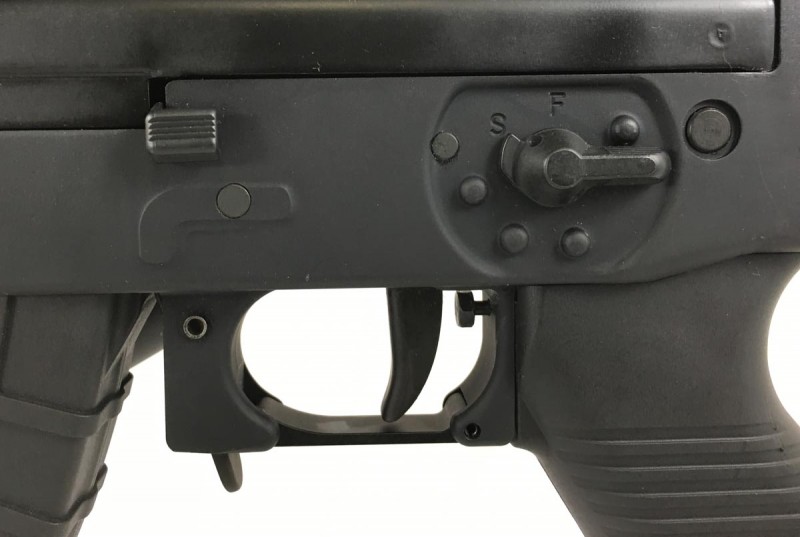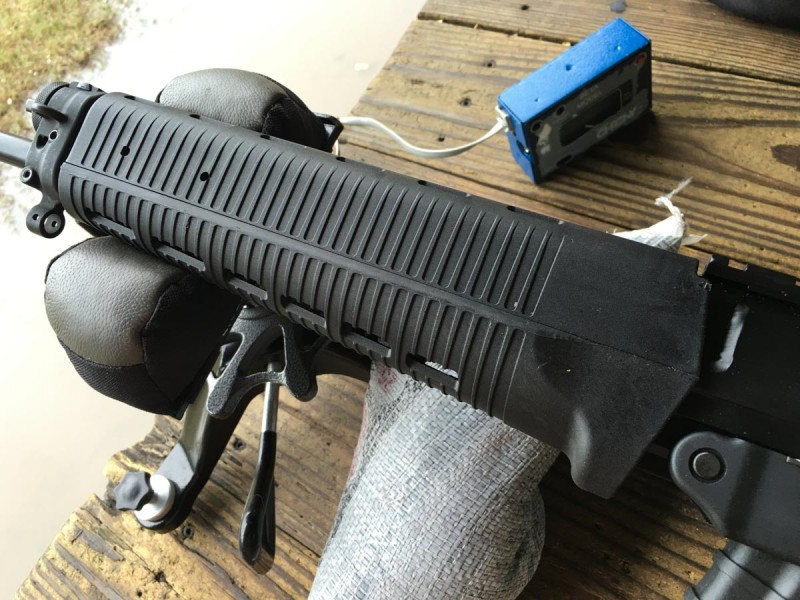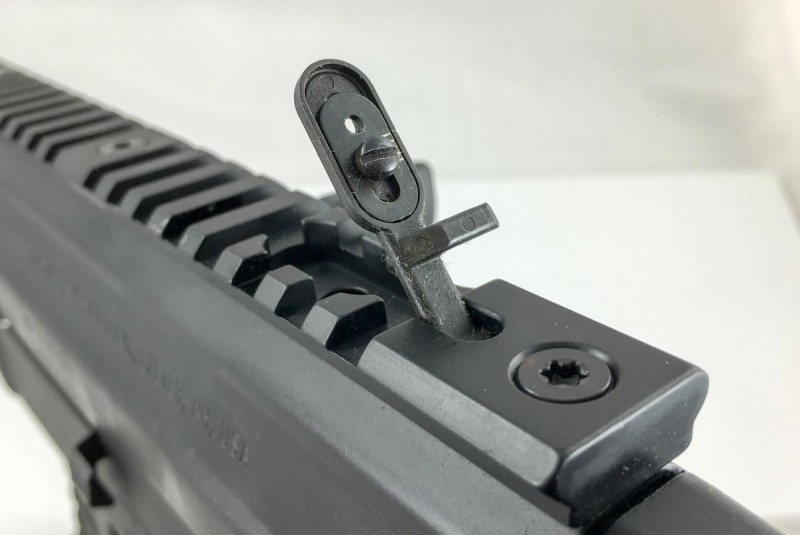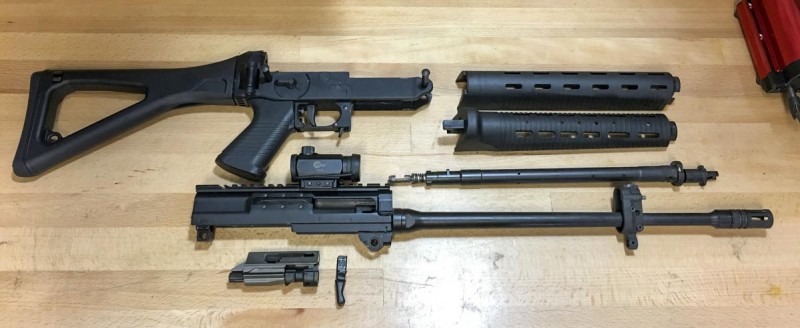This article originally appeared at OutdoorHub.

A shooter aims the Sig 556R. The 556R is chambered in 7.62x39mm and utilizes standard AK-pattern magazines. Image by Matt Korovesis.
So a Swiss watch maker, a New Hampshirite granite boy, and a Russian small arms designer walk into a bar…
Ok maybe that didn’t happen, but it could have given the eclectic roots of the Sig Sauer 556R semi-automatic rifle. While the name “556R” implies AR-type family history, this rifle diverges from the standard direct impingement Stoner rifle.

One of the benefits of the piston operation is that you can use a folding stock.
A quick tour of the Sig Sauer 556R rifle.
First and foremost, it’s a piston operated rifle, so there are no requirements for a stock buffer tube. That means there are no limitations to the type of stock that can be affixed to this handy little rifle. The standard configuration of the Sig Sauer 556R has a fixed-length folding stock. That means in the “stock open” configuration, you have a fixed length of pull. For discreet transport or operation in tight quarters, you can fold the stock into a snap-locked position along the right side of the receiver. You can reach the bolt, trigger and magazine release in this configuration and fire the gun. I tried that and have to admit it’s kind of fun. Make no mistake, if you want to shoot accurately, you’ll want to use the stock. Just know the pistol option is there if you want it.
While the rifle design is classic Sig, they’ve built the 556R to accept standard AK magazines. You’ll find a short magazine well to properly accommodate the sharply curved magazines. The magazine release is a hinged lever on the lower front edge of the trigger guard. Just push that forward to release the mag. It won’t drop free on its own accord due to the “rock in” seating method. To insert a magazine, stuff the top leading edge into the well first and rock the magazine backward until it locks into place. It’s an easy and positive operation on this rifle – you won’t be needing to finesse the magazine into the proper position.

With the exception of the bolt handle and release, controls are ambidextrous.
The magazine release is ambidextrous by design as it’s placed right in the center and it won’t care whether a right or left-hand trigger finger releases it. Identical safety levers are located on both sides of the receiver. A simple push down 45 degrees moves the control from safe to fire. I find it easier to reach and operate than a standard AR-type rifle safety.
While we’re touring the receiver area, the bolt handle is on the right side, and a bolt catch / release lever is on the left. Hold that bolt catch button down and you can lock the bolt open with or without a magazine installed. Give it slight pressure up and the bolt will release and chamber a round if there is one in the magazine.

The front hand guard is narrow but tall.
The pistol grip is hollow and has a positive locking latch, so you can store a little extra Piroshki in case you run out of field rations. The front hand guard is tall and slender. Rather than round, it’s more of an oblong shape top to bottom. The whole guard is ribbed for grip. There are two tapped areas up front on each side for attachment of short rail segments.
Speaking of rails, unlike a regular AK, this gun has an integrated rail along the full length of the receiver. That measures out to just over eight inches of rail space. There is also a very short segment on top of the gas block for attachment of a front sight. This, plus the receiver rail eliminate one of the most common complaints of the classic AK design – the difficulty of attaching optics. Even if you choose to use iron sights, the Sig 556R offers a much better configuration as the front and rear sights can be mounted almost 20 inches apart.

A pop-up rear sight is embedded into the receiver rail.
The gas system is adjustable for normal and adverse conditions, meaning if your gun gets really, really filthy you can push more gas through the system to keep it running. A small lever in front of the hand guard rotates 45 degrees counter-clockwise to switch from normal to adverse operation. The lever has a hole so you can use the bullet end of a cartridge to force it around in case the rifle is hot, or the valve is jammed.
The two-stage trigger as delivered is smooth but heavier than I like. It has about 1/4-inch of effortless takeup, followed by steady pressure until it breaks at 7 3/4 pounds of pressure. This rifle is designed for combat, so the heavier “factory default” pull probably makes sense. You’ll notice a small plunger that is pushed back into the receiver by the backside of the trigger. That controls the pressure of the second stage, so if you like, you can customize or lighten that up to your personal taste. I generally prefer single-stage triggers, but with the ability to tweak the second stage on a trigger like this, I could grow to like this functionality. The takeup on the first stage provides a little extra “security” before the shot breaks. I adjusted the second stage down to about five pounds, which I liked much better in combination with the first stage takeup. It’s a cool design once you know how to tweak it to your taste.

The plunger behind the trigger controls the weight of the second stage pull and is adjustable. Note that the trigger guard opens for gloved use.
Some basic accuracy testing.
The Sig 556R ships with a SigTac STS-081 red dot optic that includes 11 brightness settings, two of which are night vision compatible. Normally, I would keep this rifle as is because the red dot sight is well suited to this rifle. However, for a little informal accuracy, I mounted a Hawke Optics Sidewinder Tactical 10x fixed monster.

I tried some imported and domestic 7.62x39mm ammo.
First, I shot some “authentic” 7.62x39mm ammo from Ulyanovsk Cartridge Works. I can’t read most of what’s on the box, so I figured it was an appropriate match. Two different five-shot groups at 100 yards measured 2.5 and 3.1 inches in diameter. Next, I shot some groups using Winchester’s PDX1 Defender ammo. This is a self-defense round featuring a 120-grain expanding bullet that travels at 2,365 feet per second. I fired three (5) shot groups from 100 yards and measured 2.6, 2.4 and 2.9 inches respectively. While I ran out of time for this particular article, I was itching to cook up some 7.62x39mm hand loads as I’ll bet the rifle will do a lot better from an accuracy perspective. I’ll be sure to note those results in the upcoming Sig Sauer 556xi feature.
A suppressed AK?
I know, it’s not technically an AK, but, at least, it fires the same round. I was fortunate enough to get a sample of the new Griffin Armament Optimus suppressor from my buddies at The Silencer Shop. You might think of the Optimus as the ultimate Lego building kit of silencers. The main can is 9mm, or suitable for .355-inch projectiles. However, Griffin builds the Optimus in such a way as to handle the pressures of rifle calibers, as long as they’re smaller than .355-inches. The idea is that you can buy one serialized suppressor, pay only one $200 tax stamp fee to Uncle Spendy, and outfit most any gun from a .22LR pistol to a 300 Win Mag rifle. That would include .22LR, .380 ACP, 9mm, 300 AAC Blackout, .223 / 5.56mm, .308 Winchester, and 300 Win Mag. That range also includes the caliber of our test rifle here, 7.62x39mm.

I tried this Griffin Armament Optimus suppressor using a three lug mount.
The Sig 556R includes a standard threaded barrel with a birdcage flash hider attached. After removing the flash hider and the crush washer, I installed the appropriate three lug mount that came with the Griffin Armament Optimus kit. Now we were rocking. While the 7.62x39mm round is supersonic, the suppressor did an admirable job of muting the muzzle blast noise. I ran a coupe of types of 7.62x39mm ammo through this configuration using the standard gas setting, and it worked like a champ. Once you shoot a suppressed rifle, you’ll never go back.

Field stripping was a piece of cake and required no tools.
The Factory Specs
Item Number: R556-762R-16B
Caliber: 7.62 X 39 mm
Overall Length: 35.875 in
Rifling: 1 in 9.5 in
Number of Grooves: 4
Barrel Length: 16.0 in
Weight w/out Mag: 7 lbs 0 oz
Mag Capacity: 30 Rounds
MSRP: $1,332.00
Summing it up.
This exact model is not in the current lineup, but that’s OK, it should be easy to find on the open market. The current offering is a more modular version of the 556R called the 556xi Russian. The good features are still present, but as part of the xi family there are more options for tweaking and customization. We’ll be taking an in-depth look at the Sig Sauer 556xi right here, so we can get into the details of that product family then.







Did you run into any reliability issues when running it suppressed?
Nope, ran just fine!